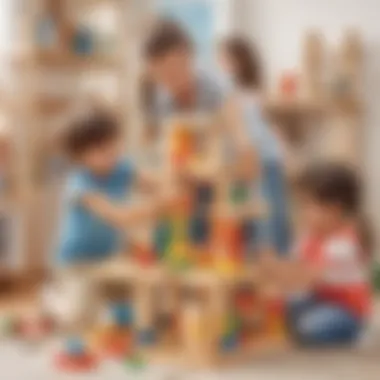Engaging Summer STEM Activities for Children


Intro
As summer rolls in, kids get their taste of freedom. The exhilarating bell that signifies school’s end rings in opportunities for exploration, creativity, and fun. One way to channel that pent-up energy is through summer STEM activities. STEM, standing for science, technology, engineering, and mathematics, may sound a bit dry but guess what? There’s a world of excitement within. In fact, summer is the perfect time to go beyond textbooks and dive into hands-on projects that inspire curiosity and creativity.
Teaching kids through engaging methods can result in sparks of genius that one does not find just sitting in a classroom. Moreover, it allows for learning that sticks because they actually do it rather than just read about it. So, let’s take a deeper look into some enjoyable activities that can be a learning adventure and a way to keep your kids brains active when school is out.
Fun Activities Ideas
The key to a beneficial summer lies in variety. Children thrive when they are able to choose from different types of activities, combining learning with play. Here are some ideas that can foster this mixture:
Indoor Activities
When the sun blazes outside, it can be a relief to stay indoors. But being cooped up doesn’t mean fun has to take a back seat:
- Robotics Kits: Using LEGO Mindstorms or similar kits, kids can build and program their own robots, enhancing engineering skills and problem-solving ability.
- Science Kits: Sets that let kids grow crystals or conduct simple chemistry experiments can transform your kitchen into a mini-laboratory.
- Math Games: Incorporate games that sharpen math skills while keeping things entertaining. Think of board games that revolve around numbers or logic puzzles.
Outdoor Adventures
Nature is the biggest classroom available, waiting to be explored. With a bit of imagination, outdoor activities can turn into STEM discoveries:
- Nature Scavenger Hunt: Create a list of items for kids to find, like different types of leaves or rocks, and discuss classifications as they tick them off.
- Build a Birdhouse: Engaging in carpentry not only practices engineering fundamentals but also provides a home for local wildlife.
- Gardening Projects: Planting a garden can teach children about biology and the ecosystem. They can track growth, chart the phases of development, and even learn about responsible water use.
Arts and Crafts
Art and science often go hand in hand. Combining them can truly spark creativity:
- DIY Instruments: Use recycled materials to create new sounds, experimenting with different shapes and sizes to explore acoustics.
- Nature Art: Utilize items found during outdoor adventures to make art pieces, promoting creativity along with environmental awareness.
Science Experiments
Nothing beats the thrill of a good experiment. Simple, safe experiments can be fun and educational:
- Homemade Volcano: Baking soda and vinegar create an explosive combination that illustrates chemical reactions.
- Invisible Ink: Using lemon juice to write secret messages can introduce kids to chemistry and enhance their writing skills as well.
Cooking and Baking
The kitchen is full of scientific potentials. Cooking teaches not only math and measuring but also chemistry:
- Recipe Experiments: Allow kids to tweak ingredients in a recipe and observe what happens, enabling a hands-on experience with measurements and transformations.
- Edible Chemistry: Discuss how certain ingredients combine while making dishes like bread or pasta, creating a connection between culinary arts and chemistry.
Engaging kids in hands-on learning during summer builds a foundation for lifelong skills and creates memories that linger long after the season ends.
Preamble to Summer STEM Activities
As the warm weather rolls in, kids are ready to kick back, soak up sunshine, and enjoy their time off from school. However, parents and guardians often find themselves in a bit of a pickle, searching for ways to keep their little ones engaged in meaningful activities. This is where summer STEM activities come into play, serving as a bridge between relaxation and educational engagement.


STEM, standing for Science, Technology, Engineering, and Mathematics, isn't just something to think about during the school year. During the summer months, it can become an exciting arena for kids to unleash their creativity while exploring the world around them. Not only does this hands-on approach to learning make for great summer fun, it also helps maintain and strengthen skills acquired in the classroom.
Kids don't have to be bookworms to appreciate the wonders of STEM. Through engaging experiments and projects, they can see firsthand how concepts like gravity, chemical reactions, or coding come to life. This active learning method keeps their brains buzzing and their curiosity piqued.
The Importance of STEM Education
In today's fast-paced world, a solid foundation in STEM subjects can't be overstated. It equips children with critical thinking skills that are indispensable, no matter their future career path. From understanding basic physics principles to learning how to code, STEM education sparks a passion for inquiry and innovation.
Furthermore, these fields are increasingly shaping our daily lives, and getting a jumpstart on these subjects provides kids with crucial tools to adapt to future challenges. Consider a scenario where kids who engage in summer STEM activities turn into adults who lead innovations in tech or sustainable living. The benefits of STEM education ripple well beyond the schoolyard.
Benefits of Summer Learning
Summer seems to last forever for children, but without structured activities, their skills can start to fade faster than ice cream on a hot day. Enter summer learning—with its roster of activities designed to keep kids' minds sharp. Here are just a few perks of maintaining mental engagement during these sunny months:
- Retention of Knowledge: Regularly engaging in educational activities helps retain what was learned during the school year, preventing the dreaded summer slide.
- Development of Lifelong Skills: Kids learn to problem-solve, engage in critical thinking, and think innovatively, all while having fun. In the long run, these skills prove essential in both academic pursuits and daily life.
- Encouragement of Exploration: Summer STEM activities allow children to explore new interests. Whether it’s building a robot or conducting a chemistry experiment, they can find what ignites their passion.
- Fostering Social Skills: By participating in group activities, kids can build friendships and work as a team. Collaborative learning encourages communication and sharing of ideas.
Types of Summer STEM Activities
In the grand scheme of enriching children’s learning experiences, summer STEM activities stand out as both essential and enjoyable. They provide an opportunity for youngsters to dive into science, technology, engineering, and mathematics in ways that traditional classroom settings often cannot. These activities nurture critical thinking, ignite creativity, and enhance problem-solving skills, creating a solid foundation for lifelong learning. With the right activities, what often feels like idle time during the summer can turn into moments of discovery and innovation.
Science Experiments at Home
Who doesn’t love a bit of magic? Science experiments bring a touch of enchantment to the everyday and can easily be done in the comfort of your own kitchen. Simple experiments, like making a volcano using baking soda and vinegar, not only present kids with a hands-on experience but also teach them about chemical reactions.
Other delightful options include growing crystals using sugar or salt, where kids can observe changes over several days. This slow progression encourages patience and observation, skills that are pivotal in scientific study. Moreover, using household items makes these projects easily accessible.
"Science is curiosity in action, especially when kids are the ones asking the questions."
Engineering Challenges Outdoors
Take learning outside and let imaginations soar! Engineering challenges can transform a simple day in the park into a testing ground for budding engineers. Build a bridge out of twigs or design a water rocket using plastic bottles.
Encouraging kids to think critically about the materials at their disposal will not only stimulate their engineering skills but will also teach them about structural integrity and design principles. Furthermore, this outdoor play promotes active engagement with nature, crucial for their overall development and well-being.
Technology Projects with Everyday Tools
The digital landscape could be intimidating, but technology projects can be simple and relatable. For instance, programming a robot or creating basic animations with a free online tool can introduce kids to the world of coding in a playful manner. Incorporating technology using common devices such as smartphones or tablets makes the learning curve less steep.
Moreover, projects that involve making DIY gadgets can enhance a child’s understanding of how things work. Kids can repurpose old electronics into something new, fostering both creativity and resourcefulness.
Mathematics Games and Puzzles
Numbers can be fun! Mathematics games that incorporate puzzles and hands-on activities can transform a dreary summer into a mentally stimulating adventure. Think of setting up a scavenger hunt that involves solving math problems to find clues. Games like these encourage teamwork and logical thinking.
Moreover, utilizing everyday scenarios – like cooking where measurements are needed – can be a great way to blend learning seamlessly into daily life.
Such creative approaches not only enhance mathematical skills but make children view math as an enjoyable challenge rather than just a subject they need to pass in school.


Closure
Overall, engaging kids in STEM-related activities during the summer opens doors to a universe of exploration. While each type of activity contributes uniquely, the overarching goal remains the same: to cultivate a sense of wonder, creativity, and critical thinking. The potential learning doesn’t just reside within each subject but transcends into developing resilient and inquisitive individuals.
Implementing Summer STEM at Home
Incorporating STEM activities into the home setting can feel daunting, yet it’s a brilliant way to facilitate learning outside the traditional classroom. It offers an opportunity for children to engage with science, technology, engineering, and mathematics in a relaxed environment. By boarding this journey, parents and guardians can lay a robust foundation for their kids, enhancing problem-solving abilities and nurturing their innate curiosity.
Creating a conducive space for learning is step one. It’s not just about gathering tools and materials; it’s about fostering a mindset where kids feel free to explore and experiment. Engaging in STEM activities over the summer allows children to make connections between concepts they learn and their everyday lives, ultimately reinforcing their understanding and retention of material. The benefits stretch far beyond just awareness of STEM subjects. Rather, they feed into critical life skills such as collaboration, communication, and creativity.
Creating a STEM-friendly Environment
Establishing a STEM-friendly atmosphere at home is less about procurement and more about perception. You want to cultivate a space where inquiry and experimentation become part of the daily routine. Here are several key elements worth considering:
- Flexible Learning Spaces: Create areas that can be easily reconfigured to suit different projects. Think of a corner with a table for building, some open floor space for large projects, or even outdoor access for experiments involving nature.
- Resource Availability: Stock up on common items like cardboard, tape, and scissors. Simple household products can spark creativity and provide endless opportunities for hands-on experiments.
- Encourage Exploration: Inspire your children to ask questions and explore answers. This encourages them not just to follow instructions but to think critically and innovate.
- Visibility of Projects: Dedicate a wall or a bulletin board for displaying ongoing or completed work. This not only boosts confidence but also serves as a reminder of their abilities and creativity.
Creating this type of environment can ease the pressure of making every project perfect. Instead, the focus shifts to the process, allowing kids to enjoy trial and error without the weight of expectation weighing them down.
Setting Goals and Expectations
With an environment set up for success, the next step is to establish clear goals and expectations for your summer STEM activities. Goals don’t have to be lofty; sometimes, small, achievable targets can inspire more sustained engagement. Here’s how you can approach this:
- Discuss Interests: Talk to your kids about what they find interesting in science, technology, engineering, and math. Make a list of activities that align with those interests. This ensures they are more excited about what they are doing.
- Set Simple Milestones: Setting achievable milestones can help track progress and encourage toddlers to stick with a project. Aiming to finish a project or learn a new skill by the end of the month can provide a welcomed structure.
- Promote Self-Assessment: Encourage children to reflect on their progress. Ask questions like, "What did you enjoy?" or "What was tricky?" This allows them to build self-awareness and critical thinking skills.
- Adaptability: Recognize that plans may change, and that's okay. Flexibility allows for adaptation based on what works for your family. If a concept isn’t clicking, pivoting to something that resonates more can reignite enthusiasm.
“Learning is a treasure that will follow its owner everywhere.”
In setting these goals and expectations, you create a roadmap for exploration while still allowing space for spontaneity and creativity. This balance is essential in keeping the summer engaging and enriching.
Implementing summer STEM activities at home is about creating experiences that ignite curiosity. With the right environment and well-defined goals, children can enjoy an impactful learning journey, one that extends far beyond their summer break.
Resources for Summer STEM Activities
Access to quality resources is pivotal in enhancing children's summer STEM experiences. These resources not only provide ideas and inspiration but also help in structuring learning in a way that feels less like a chore and more like an adventure. By incorporating books, online platforms, and workshops, families can tailor learning experiences that match their children's interests and capacities.
Beyond mere enjoyment, these resources help to ignite curiosity and foster a deeper understanding of science, technology, engineering, and mathematics. The right resources can make all the difference, transforming abstract concepts into tangible learning opportunities that resonate with kids.
Books and Literature Recommendations
Books present an invaluable avenue for learning during the summer months. They can inform, inspire, and often spark the imagination in ways that screen time might fail to achieve. Below are some notable recommendations that blend fun with education:
- "Ada Twist, Scientist" by Andrea Beaty - This whimsical tale encourages kids to ask questions and explore, making it a great introduction to scientific thinking.
- "The Way Things Work" by David Macaulay - This engaging book demystifies the mechanics behind everyday inventions. It's perfect for curious young minds interested in engineering.
- "What If? Serious Scientific Answers to Absurd Hypothetical Questions" by Randall Munroe - While a bit more advanced, this book can entertain teens and tweens with thought-provoking scenarios and scientific reasoning.
Additionally, diving into encyclopedias or science magazines can stimulate a child's interest in various STEM topics. Websites like Britannica offer a wealth of articles that parents can explore with their children, presenting complex subjects in an easily digestible format.
Online Platforms and Workshops


The digital world is ripe with opportunities for learning, especially when it comes to STEM activities. Several online platforms host interactive courses, engaging videos, and tutorials that can elevate a child's understanding of specific topics.
- Khan Academy - Known for its free educational resources, Khan Academy provides comprehensive courses on math and science that can be accessed anytime. It turns traditional learning on its head, allowing kids to progress at their own pace.
- Tynker - This platform focuses on teaching kids coding through games and challenges, instilling technological skills of utmost importance in today's world.
- Coursera - Featuring courses led by top universities, parents can find age-appropriate workshops on STEM subjects, such as robotics or environmental science, suitable for older kids and teenagers.
Moreover, many local libraries have summer workshops and programs that parents can leverage. Joining a community of learners can enhance the experience, making it more collaborative and enriching. Kids can share ideas, tackle challenges together, and discover new concepts in a social setting.
"Incorporating a mix of fun and educational resources during the summer can keep kids engaged while reinforcing their STEM skills."
In summary, the right resources are key to making summer STEM activities not just educational but genuinely enjoyable. Books can ignite imagination, while online platforms can offer limitless knowledge. With these tools in hand, parents can create an enriching summer learning environment.
Community Involvement and Collaboration
Involving the community in summer STEM activities can significantly enrich the experiences for children and their families. When kids step out of their usual home environment and engage with neighbors, local organizations, or schools, the learning becomes more dynamic and relatable. Collaboration fosters a sense of belonging and collective learning.
Collaboration isn't just about joining forces; it's about sharing ideas, resources, and, most importantly, enthusiasm. When kids see adults and peers involved in STEM, their excitement and curiosity can soar. Here are a few reasons why community involvement makes a world of difference in summer STEM activities:
- Broadened Perspectives: Engaging with a variety of people exposes children to diverse experiences and viewpoints, enhancing their creativity and critical thinking.
- Resource Sharing: Local libraries, museums, and science centers often have programs or resources that families can utilize for free or at low cost. Collaborating with these institutions can open new doors and provide valuable materials.
- Networking Opportunities: Creating connections within the community can lead to new interests and future collaborations. Parents can find support from others who share similar goals for their children’s education.
Participating in Local STEM Events
Joining local STEM events can be an eye-opener for both kids and parents. From science fairs to community workshops, these occasions are not just about competition; they offer unique opportunities for collective learning. Children can see real-world applications of their skills, and this can inspire greater enthusiasm for STEM subjects.
Local STEM events often feature:
- Hands-on Activities: Many events have hands-on experiments and challenges. Kids get to engage in real scientific practices rather than just reading about them in a book.
- Guest Speakers and Educators: When experts share their knowledge, kids gain insights they wouldn’t encounter otherwise. Listening to real scientists or engineers can spark dreams and aspirations.
- Community Involvement: Events foster relationships and cooperative problem-solving among families, strengthening community bonds.
Building a STEM Network with Other Families
Creating a network with other families focused on STEM can yield countless benefits. When parents and kids come together, they can support one another, share ideas, and even tackle projects jointly.
Consider the following when building your STEM network:
- Organizing Playdates: Set up informal meetups where kids can engage in targeted STEM activities with each other. A buddy may help a child who is shy to explore a new project or experiment.
- Sharing Resources: Families can pool their resources to acquire materials more affordably. This could be as simple as sharing books, kits, or even tools, thereby ensuring a variety of STEM experiences.
- Collaborative Projects: Think about taking on larger STEM projects that would be too overwhelming individually. For instance, building a simple robot or creating a gardens’ eco-system could be exciting group undertakings.
While summer may signal a break from school routines, it doesn’t have to mean a pause in learning. By pulling together local communities and building networks among families, children can enjoy a richer, more engaging summer filled with discovery and innovation.
"The best way to predict the future is to create it." - Peter Drucker
Epilogue: The Lasting Impact of Summer STEM Activities
In looking back over the vast array of summer STEM activities, it becomes clear that these experiences carve out a significant playground for discovery and learning. Engaging in summer projects is not just an escapade from the classroom; it’s a way to weave education into the fabric of daily life. Children, through hands-on experiments and engaging challenges, aren't merely consuming information; they are actively constructing their own knowledge.
The importance of these activities truly shines when we consider their long-term impact. Kids learn to approach problems logically, think creatively, and collaborate effectively. These are skills that go far beyond summer break. As they dissect a simple circuit or strategize a bridge-building project, they’re developing critical thinking and problem-solving skills applicable in all areas of their lives.
Moreover, because STEM activities are often project-based, they enhance a child’s ability to persist through failures. When an experiment doesn’t yield the expected results, kids learn to analyze why and refine their approach. It’s a lesson in resilience that is invaluable in today's world, where adaptability is key.
"Learning is a treasure that will follow its owner everywhere." — Chinese Proverb
In terms of emotional development, engaging in STEM activities also explores various social dynamics. Team projects encourage communication, while individual challenges promote self-esteem. Both of these are integral to a child's development and help form a well-rounded individual.
In the context of summer, when the schedule may seem less structured, these STEM experiences provide a framework that keeps children engaged and motivated. They offer a respite from the screens that dominate other forms of entertainment, pulling kids outside or to a workbench with tangible materials.
So, as parents, educators, and caregivers reflect on the summer, it’s essential to recognize the seeds planted through these activities. The benefits extend far beyond the warm months; they prepare children not just for academic endeavors but also for life as innovative, curious, and resilient individuals. Through nurturing a love for science, technology, engineering, and mathematics, we pave a path for future innovators, thinkers, and leaders.



